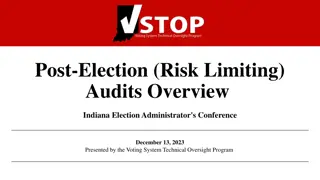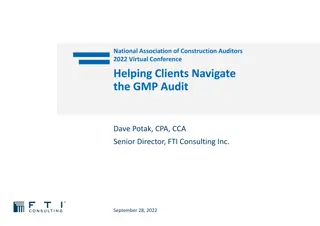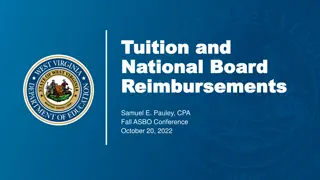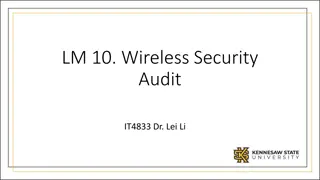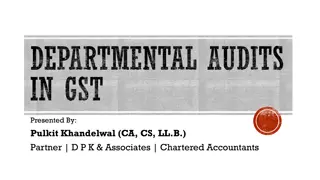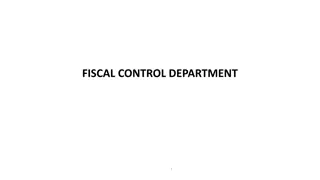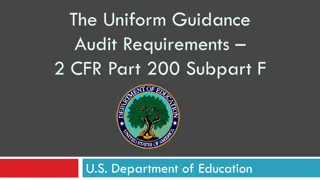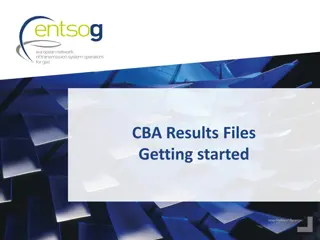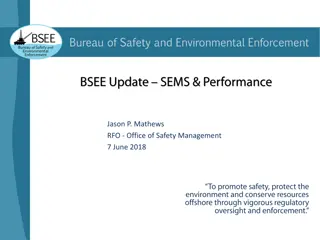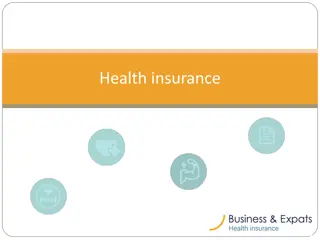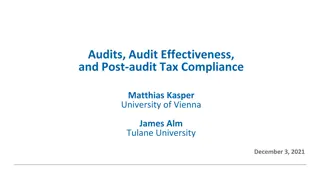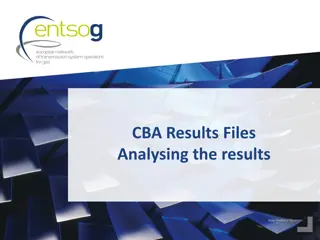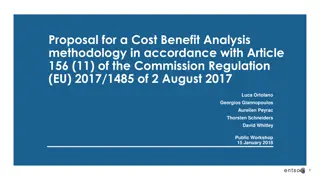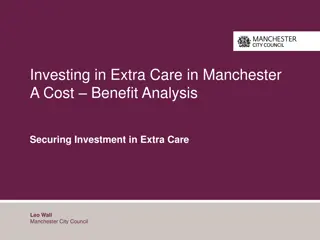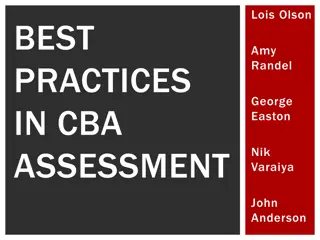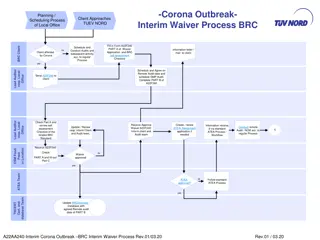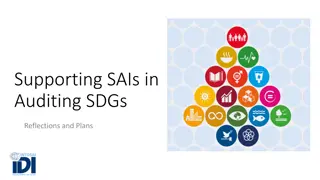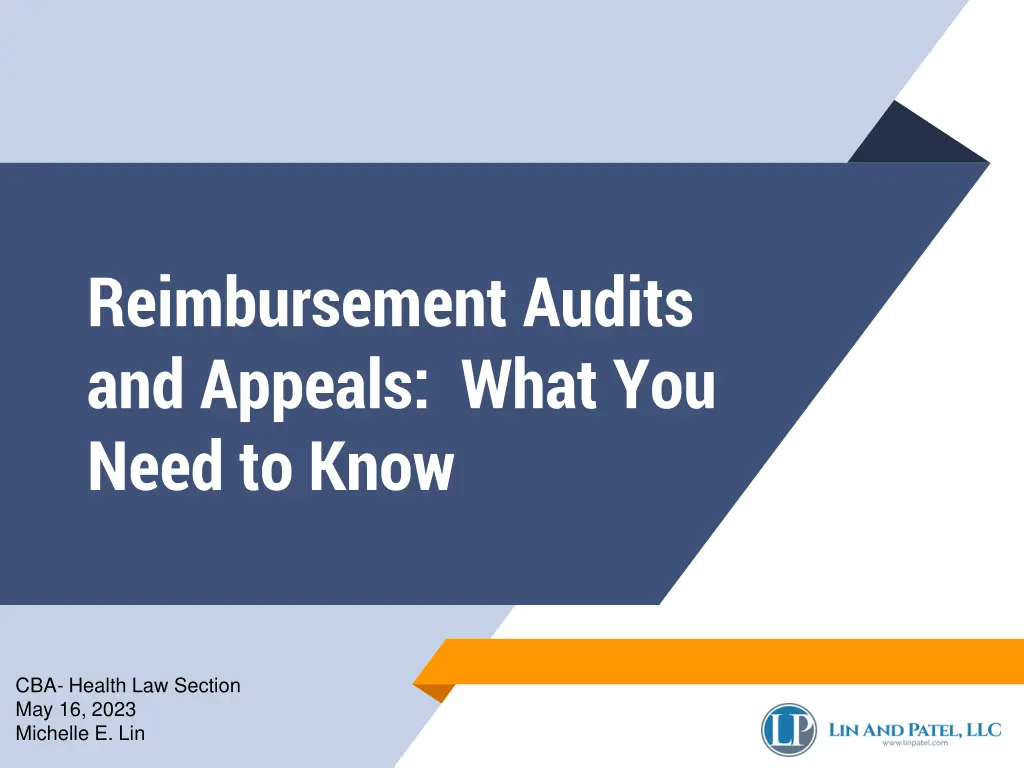
Understanding Healthcare Reimbursement Audits and Appeals
Explore the essentials of healthcare reimbursement audits and appeals, including why providers are audited, the appeals process, response to overpayment demands, types of audits, commercial payor audits, audit triggers, regulations permitting audits, and more. Gain insights into the Medicare program, audit contractors, and common triggers for audits under Parts A and B.
Download Presentation

Please find below an Image/Link to download the presentation.
The content on the website is provided AS IS for your information and personal use only. It may not be sold, licensed, or shared on other websites without obtaining consent from the author. If you encounter any issues during the download, it is possible that the publisher has removed the file from their server.
You are allowed to download the files provided on this website for personal or commercial use, subject to the condition that they are used lawfully. All files are the property of their respective owners.
The content on the website is provided AS IS for your information and personal use only. It may not be sold, licensed, or shared on other websites without obtaining consent from the author.
E N D
Presentation Transcript
Reimbursement Audits and Appeals: What You Need to Know CBA- Health Law Section May 16, 2023 Michelle E. Lin
Objectives Why are Healthcare Providers Audited? What is the Appeals Process? How to Respond to Overpayment Demands? What are Audits? What are the Types of Audit? How about Commercial Payor Audits? Who Performs Audits? How Does a Client/Provider know it has been Audited? What Triggers Audits? What are the Regulations Permitting Audits? How to Respond to Audits? Are there Appeal Rights? 2
Background- Reimbursement and Audits Reimbursement -payment to healthcare providers for services rendered to patients Medicare government as payor, the Centers for Medicare & Medicaid Services (CMS) runs the Medicare Program. CMS is a branch of Dept. of Health & Human Services (HHS) Medicare administers Part A, B, C, D CMS also monitors Medicaid programs CMS-Center for Program Integrity monitors program integrity In 2017, Medicare covered >$58 million people. Total expenditures in 2017-$705.9 billion In 2021, commercial insurance, or insurance provided by employers covered >$156 million people. Total expenditures estimated at 246% more than Medicare Many areas for fraud, waste and abuse 3
Medicare Audit Contractors Prepayment review v. post-payment review is key MAC- Medicare Administrative Contractor (e.g. NGS, Noridian, Palmetto, Novitas, WPS, CGS, FCSO) (Pre and post) Zone Program Integrity Contactors (ZPIC) (Post) Unified Program Integrity Contractors (UPIC) (Post) Supplemental Medical Review Contractors (SMRCs) (Post) RAC- Recovery Audit Contractor (Post) Payment Error Rate Measurement (PERM) (Post) Comprehensive Error Rate Testing (CERT) (Post) 4
Triggers for an Audit under Parts A and B Can be from desk, automated, complex, field Examples: Unbundling Upcoding Medically unlikely edits Incorrectly coded services Excessive use of certain modifiers Billing more than the average number of codes based on the date of service Unclear signatures or missing signatures Insufficient documentation Billing for service not performed Identify improper payments from Medicare Part A and Part B claims Item or service is not reasonable and necessary (non-covered services) Item or service is statutorily excluded Item or services does not fall into a Medicare benefit category Payments for items or services that do not meet Medicare s coverage and medical necessity criteria Payment for services where the documentation submitted did not support the services ordered Item or service does not meet other Medicare program requirements for payment National Coverage Determination (NCD) Local Coverage Determination (LCD) 5
Initial Audit Response Providers should respond timely to audits; deadlines are firm Identify type of audit to determine seriousness of audit Pull requested medical records; review internally first prior to submitting records Submit medical records with Position Statement 6
Medicare- Appeals Medicare Parts A and B claims Other appeals Cost Reports- to Provider Reimbursement Review Board (PRRB) EHR payment incentive determinations- to PRRB Enrollment determinations- to Departmental Appeals Board (DAB) Survey findings- to DAB 7
Medicare- Appeals Initial redetermination by MAC 120 days to request; 60 days to decide; Note: Recoupment begins 41 days, must file appeal early before 30 days Reconsideration by QIC 180 days to request; 60 days to decide; Note: Must file QIC reconsideration early before 60 days to stop recoupment; establish payment plan with Treasury if large overpayment First Level- Redetermination Second Level- Reconsideration Third Level- Administrative Law Judge ALJ hearing if $180 or more in controversy (2023 threshold); 60 days to request; 90 days to decide; Note: No new evidence unless good cause Fourth Level- Medicare Appeals Council Medicare Appeals Council 60 days to request; 90 days for decision Judicial review in federal court if $1,850 or more in dispute (2023 threshold), 60 days to request; Note: at this stage, presumption if several levels were unfavorable, not likely to result in favorable decision Fifth Level- Federal Court 8
Alternative Dispute Resolutions Administrative Settlement for Certain Hospitals to Resolve Appeals of Patient Status Denials On-the-record Adjudication Prior Authorization Durable Medical Equipment, Prosthetics, Orthotics, and Supplies (DMEPOS) Discussion Demonstration OMHA Settlement Conference Facilitation Low Volume Appeals Statistical Sampling Initiative 9
Medicare Appeals Decisions Fully favorable Partially favorable Fully unfavorable Partially unfavorable Note: For partially favorable claims, need to make sure Note: For partially favorable claims, need to make sure MAC refunds the provider or reduces overpayment total MAC refunds the provider or reduces overpayment total 10
Medicare Appeals- Special Considerations Extrapolation- auditor collects a small sample of claims for review for compliance, then determines error rate of sample Extrapolation shall be used when a sustained or high level of payment error exists. Extrapolation may be used after documented educational intervention (such as in Targeted Probe-and-Educate (TPE) program) Claims final determination can be reopened By MAC, or other reviewing body, on own motion or upon provider request Within 1 year for any reason Within 4 years for good cause (see 42 CFR 405.986) At any time, if initial determination procured by fraud or similar fault At any time to correct clerical errors By QIC, ALJ or The Council within 180 days for good cause or at any time if fraud 11
Medicare Appeals Practice Points Practice Point- an appeal package should include: #1 Position Statement which: Addresses applicable NCDs or LCDs If coding issues, engage coding expert to review medical records and sign Affidavit If the appeal involves an overpayment determined through sampling and extrapolation, identify all contested sample claims in 1 appeal request and clearly state any sampling methodology challenges Argument: Limitation on Liability Provision under Section 1879 of the Social Security Act Applies Argument: Provider Without Fault under 1870(b) of the Social Security Act allows for provider waiver of liability for an overpayment in certain circumstances where a provider is without fault. The Medicare Financial Management Manual ( MFMM ) CMS Pub. 100-06 (2013) states provider is without fault when the provider exercised reasonable care in billing for and accepting payment. 12
Medicare Appeal Practice Points #2- Include a copy of the Appointment of Representative form if the requestor isn t a party and is representing the appellant #3- Include a copy of initial audit letter or the decision letter(s) from the current level of appeal If there is delay in decision on big box case, contact ALJ assigned to case to expedite hearing 13
Commercial Audits and Appeals Audits triggers and processes vary by payor (e.g. Cigna, Optum, United Healthcare, BCBS, Humana) but resemble the issues identified by Medicare Key is reviewing all applicable provider reimbursement and appeals policies Policies and timeframes vary by payor but more flexibility Resembles CMS appeals process but is not the same Sample: Humana v. Optum 14
Commercial Appeals Practice Points Prepare appeal package Include Position Statement Focus on provider following payor s policies Example: Optum 15
When to Know if an Audit Occurred Usually a simple letter requesting records with name of CMS contactor or commercial payor on top Often includes list of patients and dates of service requested Issues occur if a provider does now understand relevance of audit and how to respond Timing is key 16
Authority 42 C.F.R. 420 Program Integrity Medicare Program Integrity Manual 42 C.F.R. 1000-1008 OIG Regulations Manuals- Internet Only Manuals ( IOM )- IOM is organized by functional area (i.e., program integrity, eligibility, entitlement, claims processing, etc.) National Coverage Determinations (NCDs) Local Coverage Determinations (LCDs) Administrative Law Judge (ALJ) Decisions 17
Questions? Michelle E. Lin, Esq. Lin and Patel, LLC 161 N. Clark Street, Suite 1600 Chicago, Illinois 60601 Telephone: 773.960.5269 Fax: 312.276.4116 E-mail: michelle.lin@linpatel.com

